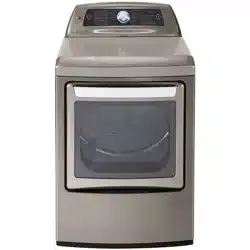Documents: Go to download!
User Manual
- Owner's manual - (English)
Use & Care Guide Dryer
FEATURES AND BENEFITS
There are several important components that are referenced in this manual.
Front of Dryer
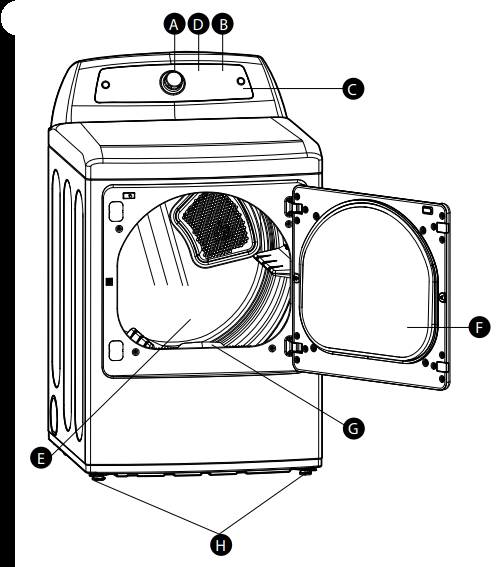
Rear of Dryer

A. EASY-TO-USE CONTROL PANEL
Rotate the cycle selector knob to select the desired dry cycle. Add cycle options or adjust settings with the touch of a button.
B. TIME AND STATUS DISPLAY
The easy-to-read LED display shows cycle status and estimated time remaining.
C. CYCLE MODIFIERS
Adjust the cycle defaults such as temperature and dry level with the touch of a button.
NOTE: Not all settings are available for all cycles.
D. CHECK VENT (Duct Blockage Sensing System)
See other models: 81562 71733 59933 61632 67022
The CHECK VENT (Duct blockage sensing system) detects and alerts you to blockages in the exhaust
system that reduce airflow from the dryer.
Maintaining clean exhaust system ducts improves operating efficiency and helps minimize service calls, saving you money
E. LARGE CAPACITY STEEL DRUM WITH DRUM LIGHT
The ultra-large stainless steel drum offers superior durability. The drum light can be turned on during a
DRUM LIGHT button on the control panel. The light also comes on when the door is opened, if the control is ON.
F. EASY-ACCESS REVERSIBLE DOOR
The wide-opening, see-through glass door provides easy access for loading and unloading. Door swing can be reversed to adjust for installation location.
can be reversed to adjust for installation location.
G. FRONT-MOUNT LINT FILTER
The front-mount lint filter allows for easy access and cleaning between loads.
H. LEVELING FEET
Four leveling feet (two in front, and two in back) adjust to improve dryer stability on uneven floors.
HOW TO USE
WARNING: To reduce the risk o fire, electric shock, or injury to persons, read this entire manual, including the Important Safety Instructions, before operating this dryer.
CONTROL PANEL FEATURES

A. POWER (ON/OFF) BUTTON
Press to turn the dryer ON. Press again to turn the dryer OFF. Pressing the POWER button during a cycle will cancel that cycle and any settings will be lost.
B. CYCLE SELECTOR KNOB
The cycle selector knob is used to select the desired dry cycle by rotating the knob in either direction until the desired cycle LED is illuminated. Once the desired cycle has been selected, the standard presets for that cycle will show in the display. These settings can be adjusted using the cycle modifier or option buttons any time before starting the cycle.
C. START/PAUSE BUTTON
Press this button to start the selected cycle. The dryer will display the estimated time (AUTO DRY) or set time (TIMED DRY) remaining and start tumbling.
To pause the cycle at any time, open the dryer door or press START/PAUSE. To resume the cycle where it was stopped, press START/PAUSE again.
NOTE: If the dryer has been stopped for more than four minutes, the dryer will turn off automatically and all settings will be lost.
D. OPTION BUTTONS
These buttons allow you to select cycle options.
Some of the option buttons have secondary functions. The controls can be locked or unlocked by pressing and holding the DRUM LIGHT button for five seconds.
E. CYCLE MODIFIER BUTTONS
Use these buttons to adjust the settings for the selected cycle. The settings light up above the buttons to show the current selection. The default temperature setting cannot be changed in AUTO
DRY cycles. AUTO DRY cycles are modified using the Dry Level button.
F. TIME AND STATUS DISPLAY
The display shows the estimated time remaining for auto cycles and actual time for timed cycles. The status of the cycle is also displayed. The CHECK
VENT indicator will illuminate if there is a serious restriction in the exhaust system.
G. CHECK VENT INDICATOR (DUCT BLOCKAGE SENSING SYSTEM)
The CHECK VENT duct blockage sensing system detects and alerts you to blockages in the ductwork that reduce exhaust flow from the dryer. This light does not indicate any problems with your dryer. If this light blinks, it indicates that your home’s exhaust system has a serious restriction, which is not covered by your dryer’s warranty.
NOTE: To protect your fabrics, not all settings are allowed in all cycles.
TIME AND STATUS DISPLAY
The Time and Status Display shows the cycle time, cycle progress, and vent status. When the dryer is turned on, the display will illuminate.
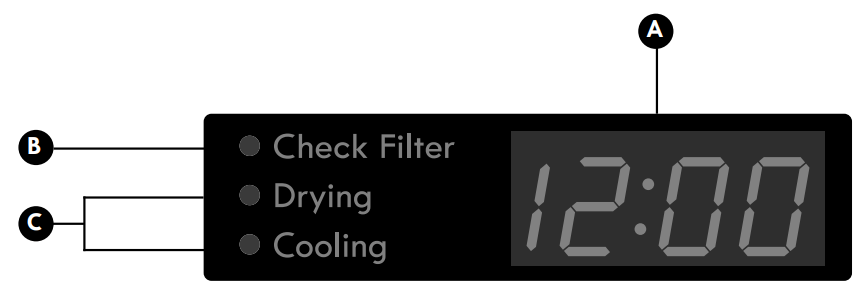

A. TIME DISPLAY
When a cycle is selected, the display will indicate the default time for that cycle including selected options or adjustments. In AUTO DRY cycles, the time remaining will be estimated and may change during the cycle, depending on the condition of the load. In TIMED DRY, the time displayed will be the actual time remaining.
B. CHECK FILTER LIGHT
The CHECK FILTER light will blink before each load, as a reminder to check the lint filter. Always clean the lint filter before every cycle.
C. CYCLE STATUS INDICATORS
This portion of the display shows which stage of the drying cycle is currently under way (DRYING or COOLING).
OPERATING THE DRYER
1. LOAD THE DRYER
Load the dryer with the wet laundry from the washer. If the load is extra large, you may need to divide it into smaller loads for proper performance and fabric care.

2. CLEAN THE LINT FILTER
If the lint filter has not already been cleaned, lift out the filter and remove the lint from the last load. This will help ensure the fastest and most efficient drying performance.

3. TURN ON THE DRYER
Press the POWER button to turn ON the dryer. The cycle LEDs will illuminate and a chime will sound.

4. SELECT A CYCLE
Turn the cycle selector knob in either direction until the LED for the desired cycle is illuminated. The preset temperature, dry level, and option settings for that cycle will display.
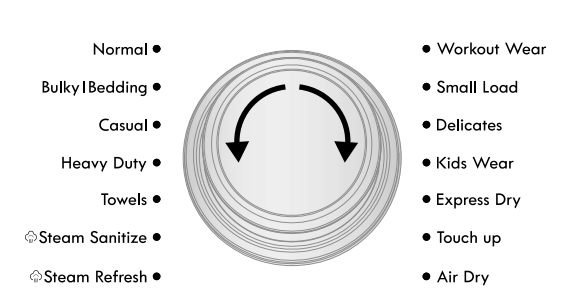
5. SELECT CYCLE MODIFIERS
Default settings for the selected cycle can now be changed, if desired, using the Temp and Dry Level buttons. NOTE: Not all options or modifiers are available on all cycles. Temperature can only be adjusted on Timed Dry cycles; Dry Level is only available on Auto Dry cycles. A different chime will sound and the LED will not illuminate if the selection is not allowed.
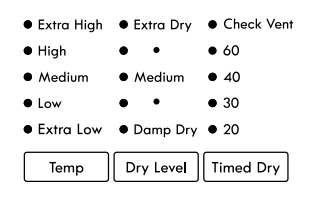
6. SELECT CYCLE OPTIONS
Cycle options can be added using the option buttons. NOTE: Not all options or modifiers are available on all cycles. A different chime will sound and the LED will not come on if the selection is not allowed.
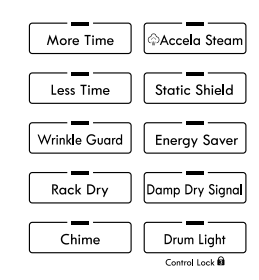
7. BEGIN CYCLE
Press the START/PAUSE button to begin the cycle. The cycle can be paused at any time by opening the door or by pressing the START/PAUSE button. If the cycle is not restarted within four minutes of being paused, the dryer will shut off and the settings will be lost.

8. END OF CYCLE
When the cycle is finished, the chime will sound. Immediately remove your clothing from the dryer to reduce wrinkling. If WRINKLE GUARD is selected, the dryer will tumble briefly every few minutes to help prevent wrinkles from setting in the clothes.
LOADING THE DRYER
WARNING: To reduce the risk of fire, electric shock, or injury to persons when using this appliance, follow basic precautions, including the following:
- Check all pockets to make sure that they are empty. Items such as clips, pens, coins, and keys can damage both your dryer and your clothes. Flammable objects such as lighters or matches could ignite, causing a fire. Failure to do so can result in fire, explosion, or death.
- Never dry clothes that have been exposed to oil, gasoline, or other flammable substances. Washing clothes will not completely remove oil residues. Failure to obey this warning can result in fire, explosion, or death.
Loading Tips
- Combine large and small items in the same load.
- Damp clothes will expand as they dry. Do not overload the dryer; clothes require room to tumble and dry properly.
- Close zippers, hooks, and drawstrings to prevent these items from snagging or tangling on other clothes.
CHECK THE LINT FILTER BEFORE EVERY LOAD
Every time the dryer is turned on, the CHECK FILTER light will blink as a reminder to make sure the filter is clean. Always make sure the lint filter is clean before starting a new load; a clogged lint filter will increase drying times. To clean, pull the lint filter straight up and roll any lint off the filter with your fingers. Do not rinse or wash the filter to remove lint. Push the lint filter firmly back into place.
Always ensure the lint filter is properly installed before running the dryer. Running the dryer with a loose or missing lint filter may damage the dryer and articles in the dryer.

USING THE TWO-WAY DOOR
The dryer is equipped with a two-way door which opens in two directions, from the side as a swing door and from the top as a hamper door.
Swing Door
Use the two-way door as a swing door when unloading, or when loading bulkier items, for easy access to the drum.
To open the swing door, insert your fingers into the handle recess on the top of the door on the side opposite the hinge and pull the door open.
CAUTION: Make sure the hamper door release is completely closed before using the swing door.
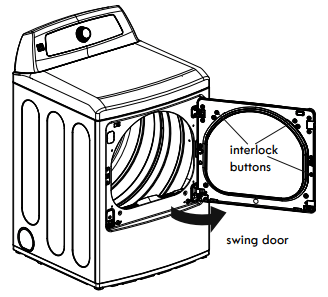
Hamper Door
Use the two-way door as a hamper door when loading. The hamper door opens about 40 degrees, acting as a chute, to help guide items into the drum and help prevent items from falling onto the floor. It also comes in handy when unloading a few small items, helping prevent the rest of the laundry from being pulled onto the floor.
To open the hamper door, press the release on the top of the door and pull the door forward.
Make sure the laundry is fully inserted in the drum before closing the door.
CAUTION: Make sure the swing door latch is completely closed before pressing the hamper door release.

CYCLE MODIFIER BUTTONS
Each cycle has default settings that are selected automatically. You may also customize these settings using the cycle modifier buttons.
AUTO DRY cycles are designed to properly care for specific fabrics and loads. As a result, not all settings are available for each cycle selection.
TIMED DRY cycles have default settings, but you may also customize the temperature setting and add options.
Settings are not limited in most timed dry cycles. Use care when setting options and modifiers for these cycles to prevent damage to your clothing.
NOTE: To protect garments, not every dry level, temperature, or option is available with every cycle
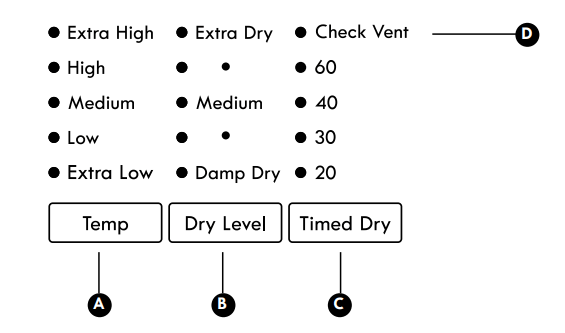
A. TEMP - Adjusts the temperature setting from EXTRA LOW to EXTRA HIGH. This allows precise care of your fabrics and garments. Press the TEMP button repeatedly to scroll through available settings. Temperature settings are not adjustable in AUTO DRY cycles.
B. DRY LEVEL - Sets the level of dryness for the selected AUTO DRY cycle. Press the DRY LEVEL button repeatedly to scroll through available settings. Use this button to adjust the dryness of the articles in the load to your preference.
- This option is not available with TIMED DRY cycles.
- The dryer will automatically adjust the cycle time.
- Selecting EXTRA DRY will increase the cycle time and dry level, while DAMP DRY will decrease the cycle time and dry level.
- Use the DAMP DRY setting for items that you wish to iron or hang for final drying
C. TIMED DRY - Allows you to manually select 20, 30, 40, or 60 minutes of dry time. Use the MORE TIME/LESS TIME buttons to increase or decrease the selected drying time in 1-minute increments. Press and hold the MORE TIME or LESS TIME buttons to rapidly change the time.
D. CHECK VENT (Duct Blockage Sensing System) - The CHECK VENT (Duct blockage sensing system) detects and alerts you to blockages in the exhaust system that reduce airflow from the dryer. Maintaining clean exhaust system ducts improves operating efficiency and helps minimize service calls, saving you money
USER MAINTENANCE INSTRUCTIONS
WARNING: To reduce the risk of fire, electric shock, or injury to persons, read this entire manual, including the Important Safety Instructions, before operating this dryer.
- Unplug the dryer or turn the power off before cleaning to avoid the risk of electric shock. Failure to follow this warning can cause serious injury, fire, electrical shock, or death.
- Never use harsh chemicals, abrasive cleaners, or solvents to clean the dryer. They will damage the finish.
REGULAR CLEANING
Cleaning the Exterior
Proper care of your dryer can extend its life. The outside of the machine can be cleaned with warm water and a mild, nonabrasive household detergent. Immediately wipe off any spills with a soft, damp cloth.
IMPORTANT: Do not use cleaning alcohols, solvents, or similar products.
NEVER use steel wool or abrasive cleansers because they can damage the surface.
Cleaning the Interior
Wipe around the door opening and seal with a soft, damp cloth to prevent lint and dust buildup that could damage the door seal. Clean the window with a soft cloth dampened with warm water and a mild, nonabrasive household detergent, then wipe dry. NEVER use steel wool or abrasive cleansers; they can scratch or damage the surface.
Cleaning Around and Under the Dryer
Vacuum lint and dust from around the dryer and underneath it regularly.
Cleaning the Lint Filter

ALWAYS make sure the lint filter is clean before every cycle. The CHECK FILTER light on the control panel will blink before every cycle to remind you.
NOTE: NEVER operate the dryer without the lint filter.
To remove lint between cycles:
- Open the dryer door.
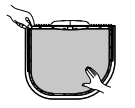
- Pull the lint filter straight up.
- Roll any lint off the filter with your fingers.
Periodic thorough cleaning: Some fabric softeners can build up on the lint filter over time. This buildup can restrict the airflow through the filter reducing dryer efficiency and lengthening drying times. After removing lint, if the filter looks dark or dirty when held up to the light, follow these steps to clean:
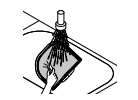
- Use hot soapy water and a stiff brush to clean the filter.
- Make sure the filter is completely dry before reinstalling it and using the dryer.
NOTE: NEVER operate the dryer with a wet lint filter.
MAINTAINING THE EXHAUST SYSTEM
Maintaining the Exhaust System
Vent ducts should be checked for lint buildup and cleaned at least once per year. If any noticeable reduction in drying performance occurs, check the ducts for obstructions and blockages.
If the CHECK VENT indicator illuminates, the exhaust system should be checked immediately for damage or obstructions. The CHECK VENT indicator signals a serious reduction in exhaust airflow which will greatly reduce energy efficiency and increase drying times. Damaged or restricted exhaust systems are not covered by the dryer warranty. Damage to the dryer that is caused by damaged, restricted, or otherwise inadequate exhaust systems is not covered by the dryer warranty
CHECK VENT Indicator
The CHECK VENT warning system is designed to help you avoid the reduced performance caused by restrictions in the household exhaust system. The CHECK VENT indicator illuminates to alert you when problems in the system occur, so you can have them repaired. While you should always check and maintain your exhaust system regularly, the CHECK VENT warning system will detect and alert you if serious problems develop in your home’s exhaust system. This includes exhaust systems that are unsatisfactory for any reason including a blockage in the venting, crushed/kinked venting, or venting which exceeds the maximum recommended length requirement as described in the installation section.
NOTE: The total length includes the length from the back of the dryer to the outside vent hood, PLUS a factor for every 90° elbow in the exhaust system. For example, if the distance from the back of the dryer to the vent hood is 30 feet, and there are four elbows in the system, then it exceeds the 28 foot maximum length allowed for those conditions.
The CHECK VENT indicator on the control panel will alert you that the exhaust system is not moving enough air from the dryer to the outside. This lack of airflow will lead to long dry times, poor drying and possibly dryer failure.
As a reminder, external dryer venting is considered part of your home and is not covered by the product warranty or protection agreements. There are services available for cleaning/maintaining the external venting.
CHECK VENT Operation
The CHECK VENT system uses components already in the dryer. By monitoring these components over the course of several cycles, the control is able to determine how much restriction there is in the exhaust system. If it detects a high level of restriction, it will turn on the CHECK VENT light to alert you to the condition. The dryer will continue to operate after the light comes on, but you should have the exhaust system cleaned or repaired immediately to avoid longer dry times and higher energy consumption.
IMPORTANT: In order for a dryer to properly and efficiently dry your clothes, it is extremely important that the exhaust system is as short and clean as possible. It MUST be less than the maximum installation requirements as outlined in the installation section. It is also very important that you make sure that when the dryer is installed, the exhaust system is clean and clear of any restrictions and is not kinked or crushed.
Failure to meet these guidelines will result in long dry times, increased energy consumption and possibly even clothing damage or dryer failure. When exhaust system restrictions become extreme, the CHECK VENT light will blink to alert you to the condition so you can have the exhaust system cleaned or repaired.
- To prevent false alarms and for increased reliability, the dryer will monitor the exhaust condition for several loads. If multiple, consecutive cycles exceed the restriction limits, the control will blink the CHECK VENT indicator.
- A blinking CHECK VENT indicator means the external venting should be checked for potential restrictions as soon as possible.
- The CHECK VENT indicator will remain active (blinking) until the restriction is resolved AND the control has verified the improved airflow for several cycles.
- After the exhaust is cleaned or repaired, it will take several cycles for the CHECK VENT indicator to reset and turn off the light.
NOTE: The CHECK VENT indicator is designed to measure performance over several consecutive cycles before activating or deactivating, to avoid false alarms. A very large load, such as a large comforter, could cause the CHECK VENT system to sense that the exhaust system is restricted, but this would not cause the light to blink. However, if several large loads were to run back to back, the CHECK VENT indicator could be activated.
TROUBLESHOOTING GUIDE
FAQs
Q: When I press a button, why does my dryer beep and then nothing happens?
A: The Control Lock feature is turned on. To turn off Control Lock, turn the dryer on, then press and hold the button that has *Control Lock on or under it for 5 seconds.
Q: Why does my dryer take so long to dry clothes?
A: Proper airflow is critical to the efficient operation of clothes dryers. A lint filter which is full of lint or clogged with fabric softener sheet residue can reduce the airflow to the point that the time required to dry clothing will be greatly increased. Another factor affecting dry time is your home exhaust system. An exhaust system which is dirty and clogged with lint, or is excessively long, needs to be professionally cleaned or repaired.
Q: Why does my dryer start by itself every few minutes?
A: This is how the Wrinkle Guard feature works. The dryer runs briefly every few minutes for up to 3 hours after the cycle finishes. This feature is designed to help prevent wrinkles from setting in when the dryer is not unloaded immediately after the cycle is finished.
Q: Why does my dryer show 3 minutes when I select the Steam Refresh cycle?
A: When the Steam Refresh cycle is selected, the dryer displays the number of garments rather than the estimated cycle time, until the cycle is started. Use the MORE TIME or LESS TIME buttons to adjust the load size setting for the number of garments you desire. For a large load or single bulky item use the  (big) setting.
(big) setting.
BEFORE CALLING FOR SERVICE
|
Problem |
Possible Cause |
Solutions |
|
*CHECK VENT indicator is blinking * This warning light is not a dryer failure and is not covered by the dryer warranty. Contact a duct cleaning service to have your exhaust system cleaned and inspected. |
Exhaust system is too long or has too many turns/restrictions. Partial blockage of the ductwork due to lint buildup or other foreign object. The appliance has detected a restriction in the external dryer venting. |
Install a shorter or straighter duct run. See the Installation Instructions for details. Ductwork should be checked/cleaned immediately. Dryer can be used in this condition, but drying times will be longer and energy consumption will increase. See the CHECK VENT INDICATOR and CHECK VENT OPERATION sections for details regarding this function. |
|
The display shows d80, d90, or d95 |
The ductwork is about 80%-95% blocked. These error codes are only displayed for 2 hours. |
Do not use the dryer until the exhaust system has been cleaned and/or repaired. Using the dryer with a severely restricted exhaust is dangerous and could result in a fire or other property damage. Check the outside dryer vent while the dryer is operating to make sure there is strong airflow. If the exhaust system is extremely long, have it repaired or rerouted. Keep the area around the dryer clean and free of clutter. Check vent hood for damage or lint clogging. Make sure the area around the vent hood is clear. |
|
The CHECK VENT indicator remains active (blinking) after clearing the restriction in the venting. |
After clearing the restriction, the CHECK VENT system requires multiple, consecutive cycles to determine that the performance value has improved before the CHECK VENT indicator is reset. |
If the CHECK VENT indicator remains active for more than five cycles after the restriction has been cleared, call for service. |
|
Dryer will not turn on |
Power cord is not properly plugged in. House fuse is blown, circuit breaker has tripped, or power outage has occurred. |
Make sure that the plug is securely plugged into a grounded outlet matching the dryer's rating plate. Reset circuit breaker or replace fuse. Do not increase fuse capacity. If the problem is a circuit overload, have it corrected by a qualified electrician. |
|
Buttons are disabled or CL shows in display |
CONTROL LOCK function is engaged. |
Press and hold the DRUM LIGHT button for three seconds to activate or deactivate the function. |
|
Error code: tE1 through tE7 |
Temperature sensor failure. |
Turn off the dryer and call for service. |
|
Display shows error code PS (electric dryers only) |
Power cord is connected incorrectly. |
White (N) and red (L2) wires on power cord. Check power cord connections for neutral connection on the center terminal. 240 volts applied to the control, so it will protect itself. |
|
Display shows error code nP or gAS |
Power cord connection is incorrect. Gas supply or service turned off (gas models only). |
Check the connection of power cord to terminal block. Confirm that house gas shutoff and dryer gas shutoff are both fully open. |
|
Light does not turn on when door is opened |
Dryer has been off for more than four minutes and light is disabled. |
Press the POWER button to turn on the dryer, which will enable the drum light. |
|
Dryer does not heat |
House fuse is blown, circuit breaker has tripped, or power outage has occurred. Gas supply or service is turned off (gas models only). |
Reset circuit breaker or replace fuse. Do not increase fuse capacity. If the problem is a circuit overload, have it corrected by a qualified electrician. NOTE: Due to the design of electric dryers, it is possible for a circuit problem to allow an electric dryer to run without heat. Confirm that the house gas shutoff and the dryer gas shutoff valves are both fully open. Even if gas is not supplied to the dryer, it will run and no error codes will display. Verify that other gas appliances in the home are working normally. |
|
Greasy or dirty spots on clothes |
Clean and dirty clothes are being dried together. Clothes were not properly cleaned or rinsed before being placed in the dryer. |
Only use your dryer to dry clean items. Soil from dirty clothes can transfer to the clean clothes in the same or later loads. Stains on dried clothes could be stains that weren't removed during the washing process. Make sure that clothes are being completely cleaned or rinsed according to the instructions for your washer and detergent. Some difficult soils may require pretreating prior to washing. |
|
Lint on clothes |
Lint filter not cleaned properly. Laundry not sorted properly. Excess static in clothes. Dryer is overloaded. Tissue, paper, etc., left in pockets. |
Remove the lint from the filter before every load. With the lint removed, hold the filter up to a light to see if it is dirty or clogged. If it looks dirty, follow the cleaning instructions. With some loads that produce high amounts of lint, it may be necessary to clean the filter during the cycle. Some fabrics are lint producers (i.e., a fuzzy white cotton towel) and should be dried separately from clothes that are lint trappers (i.e., a pair of black linen pants). Use a fabric softener to reduce static electricity. Be sure to follow the manufacturer's instructions. Over drying a load of laundry can cause a buildup of static electricity. Adjust settings and use a shorter drying time, or use AUTO DRY cycles. Divide extra large loads into smaller loads for drying. Check pockets thoroughly before washing and drying clothes. |
|
Dryer will not turn on |
Power cord is not properly plugged in. House fuse is blown, circuit breaker has tripped, or power outage has occurred. |
Make sure that the plug is securely plugged into a grounded outlet matching the dryer's rating plate. Reset circuit breaker or replace fuse. Do not increase fuse capacity. If the problem is a circuit overload, have it corrected by a qualified electrician. |
|
Buttons are disabled or CL shows in display |
CONTROL LOCK function is engaged. |
Press and hold the DRUM LIGHT button for three seconds to activate or deactivate the function. |
|
Error code: tE1 through tE7 |
Temperature sensor failure. |
Turn off the dryer and call for service. |
|
Display shows error code PS (electric dryers only) |
Power cord is connected incorrectly. |
White (N) and red (L2) wires on power cord. Check power cord connections for neutral connection on the center terminal. 240 volts applied to the control, so it will protect itself. |
|
Display shows error code nP or gAS |
Power cord connection is incorrect. Gas supply or service turned off (gas models only). |
Check the connection of power cord to terminal block. Confirm that house gas shutoff and dryer gas shutoff are both fully open. |
|
Light does not turn on when door is opened |
Dryer has been off for more than four minutes and light is disabled. |
Press the POWER button to turn on the dryer, which will enable the drum light. |
|
Dryer does not heat |
House fuse is blown, circuit breaker has tripped, or power outage has occurred. Gas supply or service is turned off (gas models only). |
Reset circuit breaker or replace fuse. Do not increase fuse capacity. If the problem is a circuit overload, have it corrected by a qualified electrician. NOTE: Due to the design of electric dryers, it is possible for a circuit problem to allow an electric dryer to run without heat. Confirm that the house gas shutoff and the dryer gas shutoff valves are both fully open. Even if gas is not supplied to the dryer, it will run and no error codes will display. Verify that other gas appliances in the home are working normally. |
|
Greasy or dirty spots on clothes |
Clean and dirty clothes are being dried together. Clothes were not properly cleaned or rinsed before being placed in the dryer. |
Only use your dryer to dry clean items. Soil from dirty clothes can transfer to the clean clothes in the same or later loads. Stains on dried clothes could be stains that weren't removed during the washing process. Make sure that clothes are being completely cleaned or rinsed according to the instructions for your washer and detergent. Some difficult soils may require pretreating prior to washing. |
|
Lint on clothes |
Lint filter not cleaned properly. Laundry not sorted properly. Excess static in clothes. Dryer is overloaded. Tissue, paper, etc., left in pockets. |
Remove the lint from the filter before every load. With the lint removed, hold the filter up to a light to see if it is dirty or clogged. If it looks dirty, follow the cleaning instructions. With some loads that produce high amounts of lint, it may be necessary to clean the filter during the cycle. Some fabrics are lint producers (i.e., a fuzzy white cotton towel) and should be dried separately from clothes that are lint trappers (i.e., a pair of black linen pants). Use a fabric softener to reduce static electricity. Be sure to follow the manufacturer's instructions. Over drying a load of laundry can cause a buildup of static electricity. Adjust settings and use a shorter drying time, or use AUTO DRY cycles. Divide extra large loads into smaller loads for drying. Check pockets thoroughly before washing and drying clothes. |
|
Clothes are wrinkled
|
Clothes dried too long (over dried). |
Over drying a load of laundry can lead to wrinkled clothes. Try a shorter drying time or LESS DRY setting and remove items while they still retain a slight amount of moisture. |
|
Clothes left in dryer too long after cycle ends. |
Use the WRINKLE GUARD option. This feature will tumble the clothes briefly every few minutes for up to 150 minutes to help prevent wrinkling. |
|
|
Clothes are shrinking |
Garment care instructions are not being followed. |
To avoid shrinking your clothes, always consult and follow fabric care instructions. Some fabrics will naturally shrink when washed. Other fabrics can be washed but will shrink when dried in a dryer. Use a low or no heat setting. |
|
Excess static in clothes after drying
|
Fabric softener is not used or used incorrectly. |
Use a fabric softener or the STATIC SHIELD option, if equipped, to reduce static electricity. Be sure to follow the manufacturer's instructions. |
|
Clothes dried too long (over dried). |
Over drying a load of laundry can cause a buildup of static electricity. Adjust settings and use a shorter drying time, or use AUTO DRY cycles. Select a LESS DRY setting on AUTO DRY cycles, if necessary. |
|
|
Drying synthetics, permanent press, or synthetic blends. |
These fabrics are naturally more prone to static buildup. Try using fabric softener, or use LESS DRY and/or shorter TIMED DRY time settings. |
|
|
Steam Features Not Working |
Water drips from nozzle when steam cycle starts. |
This is normal steam condensation. The dripping water will stop after a short time. |
|
Steam is not visible during steam cycle. |
This is normal. Check for condensation on the inside of the door during the steam portion of the cycle. Steam is not directly visible. |
|
|
Steam is not generated and no error code is displayed. |
Water level error. Unplug the dryer and call for service. |
|
|
Garments are still wrinkled at the end of the STEAM REFRESH cycle. |
Load only one to five garments (or a single bulky item). Do not mix fabric types. STEAM REFRESH is most effective on 70/30 cotton/polyblends. Do not use on 100% cotton items. |
|
|
Creases or pleats are gone from garments after Steam Refresh. |
This cycle removes wrinkles from fabric. Use an iron to replace creases and pleats in garments. |
|
|
Garments have static after using the Static Shield option. |
The amount of static that builds up when wearing garments depends on the individual moisture level in the skin. |
|
|
Garments are too damp or too dry after using Static Shield option. |
Select the load weight manually before starting the Static Shield option. |
|
|
Water drips down the door during steam cycles. |
Steam is invisible. However, under some conditions, the condensed fog may be seen, or condensation will form on the inside of the door glass and may be seen dripping down the glass. |
|
|
Drum does not turn during steam cycles. |
The drum is turned off so that the steam vapor remains in the drum. The drum will turn for only a few seconds, once a minute. |
|
|
Cannot see steam vapor at the beginning of the cycle. |
Steam is released at different stages of the cycle for each option. Steam cannot be seen, but condensation may form on the inside of the door when steam is being generated. |
|
|
Odors are not completely removed at the end of the STEAM REFRESH cycle. |
Some odors are difficult to remove. Fabrics containing certain difficult odors or very strong odors may not refresh well and should be washed or dry cleaned instead. |

